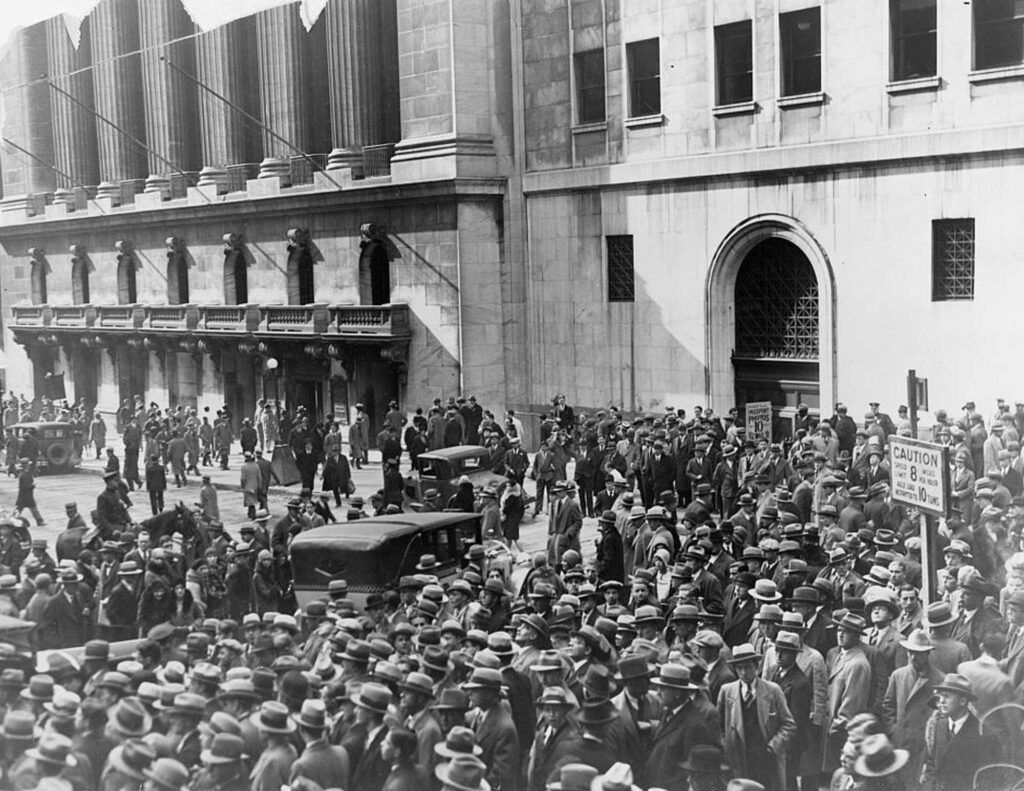
The stock market crash of 1929
On October 29, 1929, soon to be one of America’s most famous days, Black Tuesday hit Wall Street as investors traded some 16 million shares on the New York Stock Exchange in a single day. Billions of dollars were lost, wiping out thousands of investors. In the aftermath of Black Tuesday, America and the rest of the industrialized world spiraled downward into the Great Depression. Furthermore, the stocks crashed in 1929 and affected the American economy greatly.
In the 1920’s stocks were pretty much a new thing to outsiders not on wall street. However, from 1920 to 1929 stocks were grabbing people’s attention due to the fact that stocks were near quadrupling and people were making a fortune. Other investors saw this as a great opportunity for them to make their fortune as well. Investors invested in overpriced stocks because they thought the price of stocks would continue the upward trend and this speculation caused a fanze and made countless people invest their life savings into stocks. Eventually stock prices began to fall drastically whenever some stockholders decided to sell their stocks. This caused the stock prices to drop whenever the prices of stock dropped caused mass panic and caused a domino effect that eventually led to the stock market crashing.

The damages this caused on our economy was enormous and everyone was impacted by the crashing of the stock market in some shape or form. According to britannica.com “The panic began again on Black Monday (October 28), with the market closing down 12.8 percent. On Black Tuesday (October 29) more than 16 million shares were traded. The Dow lost another 12 percent and closed at 198—a drop of 183 points in less than two months. Prime securities tumbled like the issues of bogus gold mines. General Electric fell from 396 on September 3 to 210 on October 29. American Telephone and Telegraph dropped 100 points. DuPont fell from a summer high of 217 to 80, United States Steel from 261 to 166, Delaware and Hudson from 224 to 141, and Radio Corporation of America (RCA) common stock from 505 to 26.” Both individuals and businesses had invested heavily in stocks and after the crash they lost their money. People were broke because their stocks had lost value at the stock market and they could not afford to buy goods. Furthermore, they could not make new investments because they could not sell the stocks due to people’s loss of trust in the stocks. According to History.com “The day before Black Thursday, the Washington Post ran the headline: “Huge Selling Wave Creates Near-Panic as Stocks Collapse,” while The New York Times announced: “Prices of Stocks Crash in Heavy Liquidation.”
There was no single cause of the crashing of the stock market. However, there has been talk that it was about several reasons why the stock market crashed. Equally relevant issues, such as overpriced shares, public panic, rising bank loans, an agriculture crisis, higher interest rates and a cynical press added to the disarray. The banks were hit hardest by the huge savings collections and the Federal Reserve System could not bail all banks out. According to the Stock Market Crash Pbs.org “The banking system in American had almost grinded to a halt in 1993 when Franklin Roosevelt took office. The depositors had lost about $140 billion after bank closures. Therefore, people did not accept payments in checks because it was not easy to tell which checks had worth” The bankers should have lowered the rates to reduce the negative effects of margin buying. The average rate before October 1929 was 50% – 75%. Had it been lowered to 10 percent, the crash would have been shortened to a couple of months.
The stock market crash in 1929 was a great lesson to the American government and Wall Street on how not to run both the banking system and the stock market. The crash of 1929 was inadiable it was bound to happen at some point in life due to the fact that stock prices were going up so fast. This loss is what led to unprecedented levels of government intervention and the reshaping of Western Civilization economics with the New Deal and following similar regulations.
Citations
Stock market crashes on Black Tuesday, history.com
Feinberg, Barbara Silberdick, Black Tuesday : the stock market crash of (1929)
Leslie Kramer, What Caused the Stock Market Crash of 1929?
